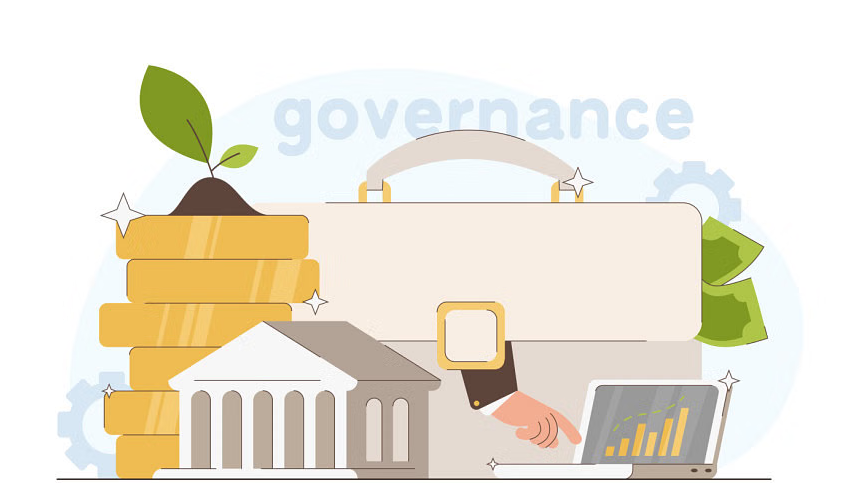Last update on: Sun Jul 27, 2025 09:00 AM
Over the last three decades, Bangladesh Bank (BB) has become an increasingly operational regulator. Today, it reviews foreign loan approvals, dollar deposit flows, and large-ticket transactions on a case-by-case basis, making BB’s role more cautious yet reactive, instead of strategic. A developing economy that wants to be a middle-income nation, such micromanagement is no longer tenable.
Globally, modern central banks focus on frameworks, not transactions. The Federal Reserve sets macro-prudential tools—capital adequacy norms, systemic liquidity thresholds, and risk-weighted asset requirements—without intervening in individual deals. The European Central Bank supervises systemic institutions but delegates day-to-day approvals to the banking layer. Even the Reserve Bank of India (RBI), long criticised for micromanagement, has shifted toward a supervisory approach that enables self-regulation through compliance-based incentives.
BB’s current role in vetting each dollar deposit linked to external commercial borrowing illustrates the core issue. Instead of setting clear rules of eligibility, compliance documentation, and risk-based pricing bands, it approves every inflow manually. This adds friction, delays, and promotes opacity. According to data from the Bangladesh Investment Development Authority (BIDA), average approval cycles for foreign loans exceed 30-45 days, undermining competitiveness in global capital markets.
Besides, the strict enforcement of the Internal Credit Risk Rating System (ICRRS) has had unintended consequences. While aiming to protect banks from poor credit exposures, it disproportionately blocks smaller borrowers from credit. Large political borrowers, often backed by implicit guarantees, face no such friction. This skewed outcome has starved innovation and enterprise finance and failed to stop the trillions of fraudulent loans in the country.
Banks, in this regime, have stopped asking fundamental questions such as how ICRR ties into forward cash flow predictability or sector-specific volatility. Instead, a compliance mindset has emerged: “Bangladesh Bank required it.” Over time, such an attitude has eroded institutional thinking capacity, making banks passive executors rather than strategic financiers. That is perhaps the most damaging long-term cost—when a regulatory environment encourages blind compliance over judgment.
A forward-looking central bank must enable rather than control by defining boundaries, building ecosystems, and letting licensed banks operate with autonomy within those boundaries. This requires: i) shifting from transactional approval to risk-based frameworks; ii) institutionalising supervisory sandboxes and early-warning systems; and iii) enabling ecosystem development instead of direct regulation.
BB should replace transaction-level oversight with sectoral risk frameworks. This includes pre-approved External Commercial Borrowing (ECB) routes for eligible companies with audited financials; risk-weighted credit windows for banks based on their capital base and non-performing loan (NPL) history; dynamic asset-liability matching rules that incentivise long-term lending; and launching multiple sandboxes to test the regulation and policies.
Countries like Malaysia have implemented credit guarantee schemes and sandbox-based regulations that allow rapid experimentation under controlled exposure. According to reports from Bank Negara Malaysia, their innovation sandbox approved 38 new financial products in 24 months with less than one percent regulatory breaches.
BB must also institutionalise a proactive supervision model rather than waiting for banks to default or misreport by building an AI-backed credit risk surveillance tool that flags high-risk portfolios; conducting quarterly asset quality reviews for banks above a certain asset threshold; integrating non-banking datasets (e.g., utility payments, tax records) into borrower scoring; and moving away from collateral-backed lending, and acknowledging other forms of assets.
The Reserve Bank of India introduced a Central Repository of Information on Large Credits (CRILC), mandating banks to report exposures above 50 million Indian rupees. This has significantly improved stress recognition timelines.
BB should catalyse markets, not dominate them. This means licensing independent credit rating agencies and asset reconstruction companies; opening up private distressed asset markets; and facilitating interbank repo and derivative markets to improve price discovery.
Vietnam and Indonesia have liberalised their NPL disposal process, resulting in a 30-40 percent recovery improvement within two years of implementation. According to the World Bank, NPL resolution in Indonesia improved from 22 percent to 63 percent post-reform between 2016 and 2019.
These steps require BB to fundamentally redesign its identity from an enforcer to an ecosystem architect. It must trust its licensed entities to operate under risk-based guardrails and reserve interventions only for systemic risks.
The banking reforms recently outlined with support from the IMF, Asian Development Bank, and World Bank offer a unique opportunity. The Distressed Asset Management Act, the Bank Resolution Ordinance, and the proposed deposit protection enhancements are foundational shifts. However, their success will depend on execution and mindset change.
More critically, Bangladesh Bank must invest in building human capital—regulators who understand structured finance, international bond markets, and fintech-led credit models. Otherwise, BB will continue to regulate yesterday’s risks with today’s tools, while tomorrow’s markets go ungoverned.
Mamun Rashid, an economic analyst, is chairman at Financial Excellence Ltd and founding managing partner of PwC Bangladesh.
Views expressed in this article are the author’s own.

